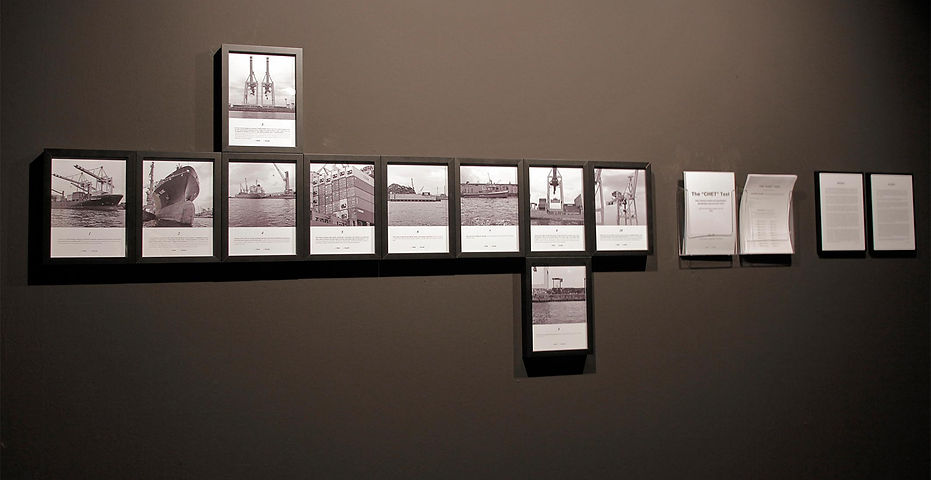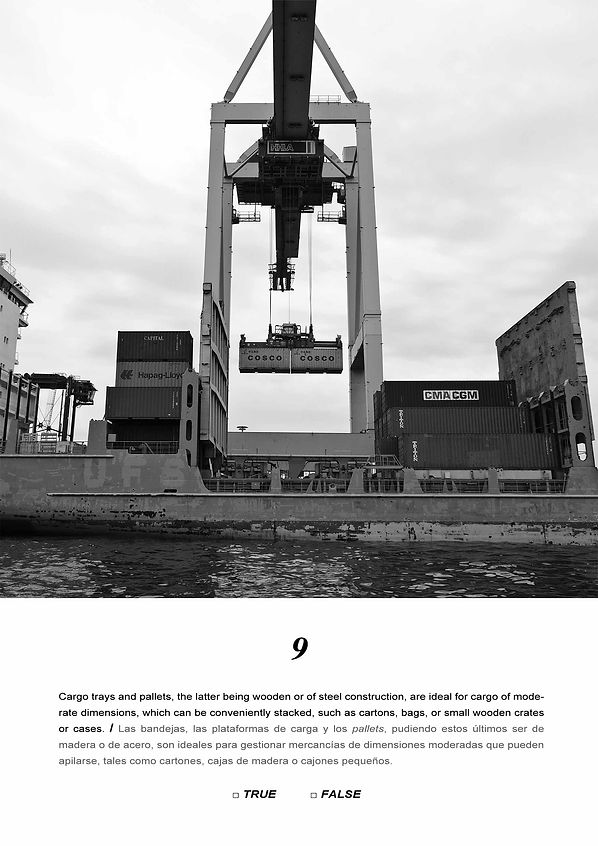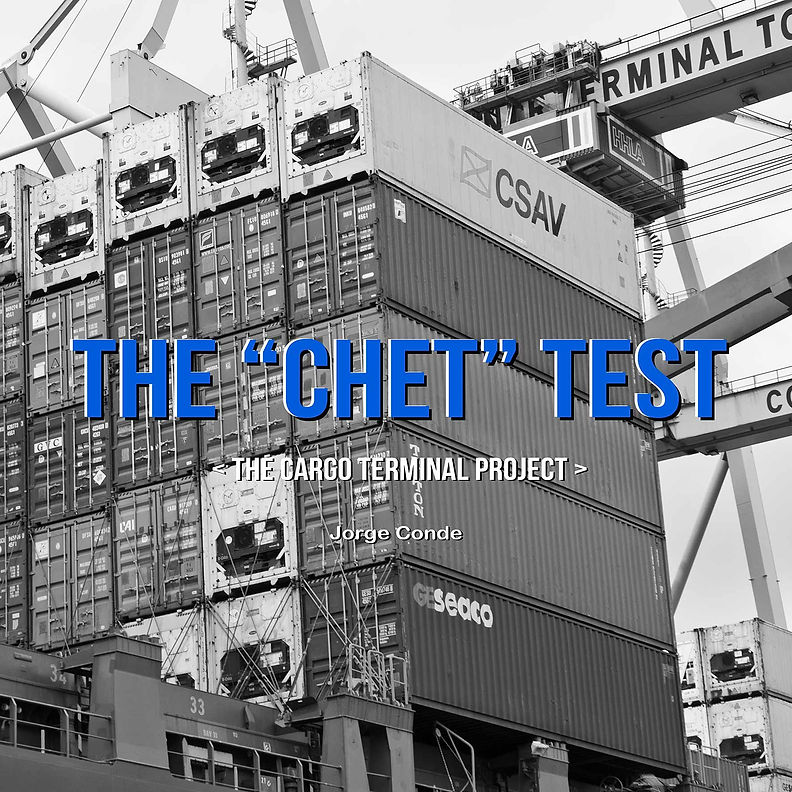The C.H.E.T. Test –
The Cargo-Handling Equipment On Board and In Port Test (”CHET”) /
Test sobre equipos para la gestión de mercancías abordo y en puerto (“C.H.E.T.”)


The C.H.E.T. Test, 2011-13
Vistas de la exposición. Casal Solleric, Palma de Mallorca, 2014.
Exhibition views. Casal Solleric. Palma (Majorca), 2014.
The C.H.E.T. Test
El Test sobre equipos para la gestión de mercancías abordo y en puerto (“C.H.E.T.”) es un examen sorpresa compuesto por 10 preguntas del tipo Verdadero / Falso que se plantea al participante sin previo aviso y con fines exclusivamente artísticos. “C.H.E.T.” puede definirse como un artefacto artístico conceptual, que puede ser participativo o contemplativo, un simulacro de examen creado como parte consustancial al proyecto The Cargo Terminal (2013) para reforzar su discurso.
Las 10 preguntas que lo componen están inspiradas, adaptadas y formuladas sobre la base del material educativo de acceso libre publicado en Internet por la Facultad de Estudios Marítimos de la Universidad de Rijeka en Croacia. Aunque las preguntas se formularon con fines exclusivamente artísticos, las soluciones que incluye el cuaderno del test son rigurosamente ciertas. El examen está redactado íntegramente en inglés puesto que aborda el tema del transporte portuario a escala global, porque se localiza en varios países, se inspira en material escrito en esa lengua y pertenece a un proyecto más ambicioso (The Cargo Terminal) de largo recorrido y alcance internacional.
En cualquier caso, al poco de iniciar el proceso creativo fui consciente de la necesidad de contar con una localización real y fuentes autorizadas de material didáctico. Trabajar con un puerto mercante emblemático y de relevancia internacional, y con una institución educativa solvente proporcionaría al test la autenticidad y el arraigo geográfico necesarios para que el experimento tuviera éxito. Fue en esta etapa cuando decidí centrar mi investigación en el Puerto de Hamburgo y adaptar los contenidos de una unidad didáctica piloto publicada por la Universidad de Rijeka como parte de uno de sus cursos en Estudios Marítimos. Como es natural, el empleo de esta estrategia “impostora” proporciona al test un mayor grado de realismo y sirve para que tanto sus contenidos como su aspecto sean más efectivos y verosímiles. Confío que, aunque el participante/observador tenga dudas sobre su veracidad, o una vez que descubra que se trata de un “falso” test, concluirá que, además de correcta, esta estrategia es legítima, coherente con mis pretensiones y ayuda a provocar la reflexión.
Por lo que respecta a las fotografías que incorpora el test, todas fueron tomadas en el Puerto de Hamburgo en el transcurso de una fructífera visita realizada en 2011. La sesión fotográfica se prolongó durante dos horas y todas las fotografías se tomaron desde una embarcación comercial con la ayuda de una cámara Olympus DSLR y dos ópticas digitales Zuiko. Posteriormente, de entre un total de 193 imágenes en bruto, se hizo una selección de 10, que en 2013 fueron procesadas digitalmente para crear esta pieza. Decir también que ninguna de estas fotografías pretende ser una ilustración fiel de los conceptos evaluados por las 10 preguntas que componen el test “CHET”. Antes bien al contrario: fueron seleccionadas y procesadas con el fin de mostrar la actividad y los distintos espacios e instalaciones del puerto de una manera tan objetiva como inexpresiva. Como es costumbre en un examen de esta naturaleza, en ellas aparecen dársenas, buques, grúas, pórticos, contenedores, maquinaria y otros equipos de uso común en muchos contextos portuarios.
Por último, me gustaría señalar que si bien las diez preguntas fueron formuladas con fines exclusivamente artísticos, las soluciones que incluye el cuaderno del test son rigurosamente ciertas.
The C.H.E.T. Test
The Cargo-Handling Equipment On Board and In Port Test (”CHET”) is a 10-true-false-question pop quiz which I designed for artistic purposes only. As a matter of fact, “CHET” can be defined as an artistic, conceptual artifact meant to be either observed or taken, a simulation test given to the participant without prior announcement and created in order to build the discourse, to integrate and reinforce the body of works included in The Cargo Terminal Project (2013 - in progress).
All 10 questions were inspired by, written and adapted from free-access learning materials developed and published on the Internet by the University of Rijeka in Croatia.
This test is not intended to be a truthful evaluation of the participant’s knowledge in the fields of Logistics, Technology and Organization of Maritime Transport, but an experimental tool aiming to make him / her reflect on today’s relevance of Maritime Transport and the huge impact this global industry has on the seascape, the urban planning of seaport cities and, ultimately, on global markets and consumer society.
Nonetheless, soon after starting the creative process I realized real locations and reliable sources were needed. Focusing on a well-known seaport and having an existing, reputed educational institution to work with would provide the test with the authentic feel and the geographical roots required for the experiment to succeed. It was at this early stage when I decided to concentrate my research on the Port of Hamburg in Germany and to adapt one sample learning unit released by the University of Rijeka (UNIRI) in Croatia as part of its offered diploma in Maritime Studies. By using this “fraudulent” strategy, both the test contents and the overall appearance of the art work would obviously be more realistic making it more effective, powerful and, most importantly, far more believable. I do hope that even if the participant / observer doubts about its truthfulness, or when is finally aware of its fakeness, he / she will still conclude this was a legitimate, coherent and thought-provoking choice.
Regarding the B&W photographs included in the test, they were all taken in the Port of Hamburg as part of an extensive visit that took place in 2011. The photo-session lasted two hours and all pictures were taken from a commercial boat with my Olympus DSLR camera using two different Zuiko digital lenses. Out of a large body of 193 raw images, 10 were later selected and digitally processed in 2013 for the creation of this specific piece. None of them is intended to be a faithful illustration of the concepts evaluated by each one of the questions that eventually made its way to the “CHET” test. Much on the contrary, they were selected and edited to show typical seaport activity and some key spots of the port’s cargo terminal in an objective, inexpressive manner. Needless to say that being “CHET” a Cargo-Handling Equipment test, some of the photos clearly depict ships, docks, TEU containers, cranes and gantries, handling facilities, lifting gear and other pieces of terminal equipment.
Lastly, I would like to point out that even though all 10 questions were made up for experimental and artistic purposes only, the answers given in this booklet are strictly correct.

The C.H.E.T. Test, 2011-13
Imagen que ilustra la pregunta nº 4 / Image illustrating question number 4

The C.H.E.T. Test, 2011-13
Cuaderno del test en expositor mural de metacrilato.
Test booklet presented in plexiglass wall-mounted display.


The C.H.E.T. Test, 2011-13
Pregunta nº 9 / Question number 9


The C.H.E.T. Test, 2011-13
Instalación. 14 piezas (10 fotos B&N enmarcadas + test encuadernado en expositor mural de metacrilato + cuaderno de respuestas en expositor mural de metacrilato + 2 textos instrucciones de uso. Configuración y medidas variables.
Installation consisting of 14 pieces (10 framed B&W photos + test booklet in plexiglass wall-mounted display + answer booklet in plexiglass wall-mounted display + 2 user instruction manuals. Variable dimensions.
